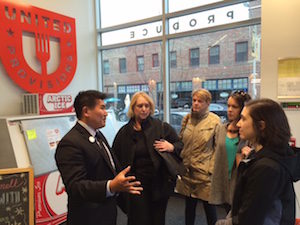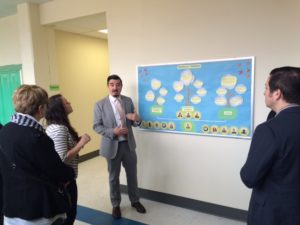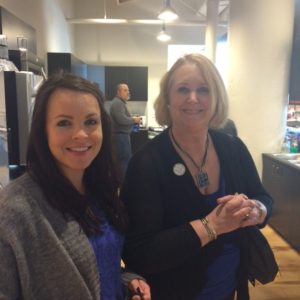Global Detroit Experiences St. Louis’ Approach: Strength in Partnerships
By Sloan Herrick and Beth Szurpicki, Global Detroit
The Welcoming Economies Global Network (WE Global) provides member organizations opportunities to learn from each other as part of its mission to strengthen the work, maximize the impact, and sustain the efforts of individual local initiatives that welcome, retain, and empower immigrant communities as valued contributors to local economies. During WE Global-funded city-to-city visits, a delegation led by one core member organization visits another core member organization to exchange ideas, learn from each other’s successes, and inspire new approaches and commitment to immigrant-focused economic development. Visits typically include meetings with local stakeholders including government, chambers of commerce, economic development agencies, and social service providers.
 In March, representatives from Global Detroit traveled to St. Louis to learn about the robust diversity and inclusion efforts in effect throughout the city. Guided by St. Louis Mosaic Project’s Betsy Cohen and Vin Ko, and joined by Welcoming America’s Christina Pope, we were fortunate to take in the city’s melange of neighborhoods, public parks and commercial corridors; meet with local leaders who partner with Mosaic in its mission to be the fastest growing U.S. metropolitan area for immigration by 2020; and see first-hand the strong web of connected services – from refugee resettlement to microlending – led by the International Institute of St. Louis. Global Detroit left St. Louis inspired by the spirit of cross-sector partnership that Mosaic has fostered across the region and energized to return to Detroit with new ideas, insights, and methods to strengthen our work.
In March, representatives from Global Detroit traveled to St. Louis to learn about the robust diversity and inclusion efforts in effect throughout the city. Guided by St. Louis Mosaic Project’s Betsy Cohen and Vin Ko, and joined by Welcoming America’s Christina Pope, we were fortunate to take in the city’s melange of neighborhoods, public parks and commercial corridors; meet with local leaders who partner with Mosaic in its mission to be the fastest growing U.S. metropolitan area for immigration by 2020; and see first-hand the strong web of connected services – from refugee resettlement to microlending – led by the International Institute of St. Louis. Global Detroit left St. Louis inspired by the spirit of cross-sector partnership that Mosaic has fostered across the region and energized to return to Detroit with new ideas, insights, and methods to strengthen our work.
 We thought we knew our contemporaries at St. Louis Mosaic, but we only knew the half of it. On paper we fully understood the programming underway, but the special sauce, what they do undoubtedly well, lives in their approach, the way that they are working seamlessly across the community to foster a welcoming and inclusive social, cultural, and economic fabric. They do this with an open and flexible process that invites traditional economic development players like the Regional Chamber of Commerce and the Regional Business Council to partner with and support Mosaic to achieve common goals associated with increasing inclusion of immigrant and African American talent. When working to foster relationships with corporations, Cohen often asks first what Mosaic can do for their company, builds a relationship, and then takes the relationship deeper. In just two days, we visited and learned also about St. Louis’s bio-agriculture and tech incubators, explored the many facets of economic development programming offered at the International Institute, and met the World Trade Center and St. Louis Economic Development Partnership team – the parent of Mosaic.
We thought we knew our contemporaries at St. Louis Mosaic, but we only knew the half of it. On paper we fully understood the programming underway, but the special sauce, what they do undoubtedly well, lives in their approach, the way that they are working seamlessly across the community to foster a welcoming and inclusive social, cultural, and economic fabric. They do this with an open and flexible process that invites traditional economic development players like the Regional Chamber of Commerce and the Regional Business Council to partner with and support Mosaic to achieve common goals associated with increasing inclusion of immigrant and African American talent. When working to foster relationships with corporations, Cohen often asks first what Mosaic can do for their company, builds a relationship, and then takes the relationship deeper. In just two days, we visited and learned also about St. Louis’s bio-agriculture and tech incubators, explored the many facets of economic development programming offered at the International Institute, and met the World Trade Center and St. Louis Economic Development Partnership team – the parent of Mosaic.
One highlight of our trip was a visit to the South Grand Neighborhood. Along its main strip, business owners representing 14 countries run ethnic restaurants, shops, and markets. It is home to Jay International Foods – the first international foods store in St. Louis. We met and talked with the son and nephew of the immigrant-founders, Jojo, who started there as a young man and now manages the day to day operations. Jojo has the entrepreneurial spirit of thegeneration before him – he recently launched a St. Louis based-clothing line. Jojo shared with us the way that the store takes care of its customers – an ever changing mix of people from all over the world. When Jay’s opened in the 1970s, the neighborhood was mostly Asian and Latino immigrants. Over the years, as demographics have shifted to more nationalities – Vietnamese, Burmese, African and Caribbean – as well as vegetarians and South City locals, Jay’s has too – and it morphs with the neighbors it serves. Today the number of ethnicities represented within the walls of Jay’s are too many to count.
In the 1980s and ‘90s, the South Grand neighborhood was not the best part of town. At that time, the International Institute of St. Louis was located on Grand Boulevard, the main corridor of the South Grand neighborhood. The Institute often serves nearby immigrants and refugees through their language classes and other services, while others made their way to class by public transit up and down the commercial corridor. These residents started to put down roots in the area, and took advantage of business development services and investment programs to start businesses and help turn around the neighborhood. South Grand is a clear example of how immigrants in St. Louis are able to revitalize entire neighborhoods by adding vibrancy, culture, and jobs to the area. Mosaic works closely with the Institute, and refers immigrants to their programs for loans and business plan assistance, and together they’re fostering growth and prosperity in South Grand.
A short trip through Ferguson called attention to the intersection of racial disparity and immigrant economic development that is so relevant to our work. With race relations under pressure in St. Louis and Detroit, this trip galvanized for the Global Detroit team a need to continue and expand our efforts to include in our economic development work everyone who is fenced off from prosperity. We left St. Louis asking the question, what more can we do to promote equitable economic development in Detroit?
 Experiential learning has traditionally held its place in education, however, we see too its value in supporting member organizations like Global Detroit and Mosaic by creating first-hand experiences from which one can learn from the other, creatively consider measures to replicate methods and programs that work, and ultimately grow this emerging economic development sector by building off of those lessons that other members have learned. Our trip to St. Louis fits perfectly into this experiential learning paradigm. In St. Louis, we saw concrete examples of strong partnerships between Mosaic and the corporate community and garnered critical insight into how those partnerships were formed, how they are nurtured, and the advantages of these mutually beneficial relationships over time. With many parallels between St. Louis Mosaic and Global Detroit – including an ambassadors program, international student retention objectives, and working through partners to expand the reach of our efforts – we exchanged notes, discussed obstacles, and explored solutions together. In fact, because of this trip and the wealth of expertise that Mosaic had to offer, we are making adjustments to key programs and tuning-up our corporate outreach and engagement efforts.
Experiential learning has traditionally held its place in education, however, we see too its value in supporting member organizations like Global Detroit and Mosaic by creating first-hand experiences from which one can learn from the other, creatively consider measures to replicate methods and programs that work, and ultimately grow this emerging economic development sector by building off of those lessons that other members have learned. Our trip to St. Louis fits perfectly into this experiential learning paradigm. In St. Louis, we saw concrete examples of strong partnerships between Mosaic and the corporate community and garnered critical insight into how those partnerships were formed, how they are nurtured, and the advantages of these mutually beneficial relationships over time. With many parallels between St. Louis Mosaic and Global Detroit – including an ambassadors program, international student retention objectives, and working through partners to expand the reach of our efforts – we exchanged notes, discussed obstacles, and explored solutions together. In fact, because of this trip and the wealth of expertise that Mosaic had to offer, we are making adjustments to key programs and tuning-up our corporate outreach and engagement efforts.




